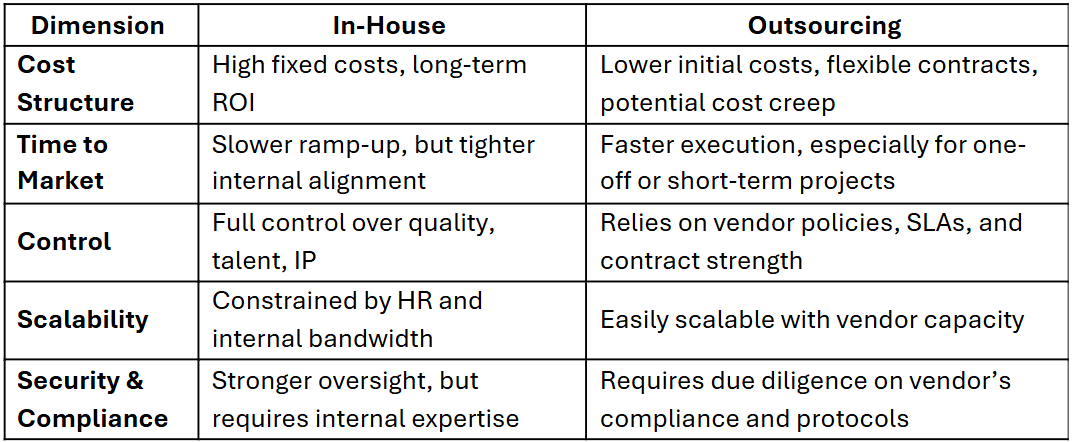









In a climate where agility, talent access, and cost efficiency define competitive advantage, C-level executives face one persistent question: Do we build in-house, or outsource? The decision between in-house operations and outsourcing has far-reaching implications, especially for growth-stage companies, digital transformation initiatives, or enterprises aiming to modernize operations.
This guide offers a structured analysis of the Outsourcing vs In-House Key Risks to Evaluate, helping leaders align operational choices with long-term strategic goals.
At its core, this decision is about control versus flexibility.
Outsourcing refers to hiring external vendors to perform services traditionally managed internally. This could include IT development, customer service, HR, accounting, or specialized roles like cybersecurity and data analytics.
In-House Operations require building internal teams, infrastructure, and processes to handle the same services under direct management.
While both models can succeed, their performance and risk profiles differ significantly. For instance, outsourcing offers rapid deployment and cost efficiency but may compromise oversight and security. In contrast, in-house teams provide greater control and cultural alignment but come with higher fixed costs and longer ramp-up times.
Internal operations come with substantial CapEx and OpEx burdens. Budgeting for recruitment, onboarding, salaries, software licenses, hardware, benefits, and management can strain startups and large enterprises alike.
Real-world insight: Companies shifting from outsourcing to in-house often see a 30–50% rise in costs during the first 12–18 months due to infrastructure buildout and hiring surges.
Scaling an in-house team is not simply a matter of budget — it’s a matter of time. Hiring pipelines, compliance with local labor laws, onboarding, and internal process alignment all introduce delays.
Example: A fintech startup expanding to three new regions in a year will face months of regulatory setup and HR compliance if hiring locally, delaying their go-to-market plan.
The global talent crunch — especially in AI, software engineering, data science, and cybersecurity — makes hiring top-tier professionals a challenge. Once onboarded, employees must be retained, engaged, and continuously trained to stay ahead of the curve.
Executive takeaway: According to McKinsey, 87% of companies are either already facing or expect to face a skills gap in the next five years.
Your internal team may be strong in core technologies or operations — but what about specialized tools, AI frameworks, or compliance domains like GDPR or SOC 2? Without continuous investment in talent development, you risk becoming outdated or inefficient.
Strategic risk: Missing just one key skill — like cloud-native architecture — can lead to inefficient infrastructure and rising tech debt.
Outsourcing gives you access to capabilities, but often limits visibility. Vendors may not align with your internal culture, quality standards, or iterative processes.
Mitigation strategy: Establish strong vendor governance, KPIs, and regular business reviews. Treat partners like an extension of your team, not a one-off vendor.
Cross-border outsourcing comes with logistical friction: time zone differences, asynchronous communication, cultural gaps, and language barriers. Agile workflows and creative iteration suffer the most under these conditions.
Leadership tip: Choose nearshore teams for easier collaboration or ensure your offshore vendor has overlapping work hours and clear escalation channels.
Outsourcing introduces risks around data access, code security, and intellectual property. If poorly managed, it can result in compliance violations or reputation damage.
Compliance action: Insist on data protection protocols, encryption, non-disclosure agreements (NDAs), and periodic security audits with your vendors.
Relying on a single external partner can introduce single points of failure. What happens if your vendor’s priorities shift, they’re acquired, or they go out of business?
Risk scenario: An outsourced DevOps partner shuts down unexpectedly, leaving your cloud infrastructure undocumented and unmonitored — causing outages.
You may enjoy: Onshore vs Offshore IT Outsourcing: A Comprehensive Comparison in 2024

Here’s a decision checklist to guide your model selection:
✅ Is the task core to your competitive advantage?
Outsource non-core functions (e.g., customer support, payroll) but consider keeping core tech or product innovation in-house.
✅ Can you recruit, manage, and retain the required talent?
If your HR team can’t attract niche skills in a timely way, outsourcing can bridge the gap.
✅ Do you need to scale quickly or launch in new markets?
Outsourcing may provide the agility you need, especially in international expansion or fast pivots.
✅ What’s your risk tolerance?
Highly regulated sectors (finance, healthcare, defense) often prefer in-house operations for sensitive workloads.
✅ What’s your total cost of ownership?
Don’t just look at invoices — consider opportunity costs, employee retention costs, and the long-term cost of inefficiency.
The decision between outsourcing and in-house operations is not a binary choice — it’s a strategic lever. The most successful C-level leaders know how to architect a hybrid model: outsource where flexibility, speed, or cost advantages exist, and build in-house capabilities where differentiation, culture, and security matter most.
Ultimately, the ability to assess and manage the Outsourcing vs. In-House Key Risks to Evaluate is a leadership competency. As industries evolve and workforce dynamics shift, revisiting your model annually — and adapting accordingly — may become a new competitive edge.
Learn more: Project-Based vs Retained Services in IT Outsourcing
Stay ahead in a rapidly changing world with our monthly look at the critical challenges confronting businesses on a global scale, sent straight to your inbox.